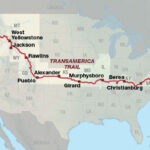Mountain biking offers unparalleled thrills, even when winter rolls around. However, braving the elements often means facing muddy trails that can quickly dampen your spirits. If you’d rather keep the mud off your face than reserve clay for spa days, investing in the right bicycle fenders for your mountain bike is crucial. We’ve delved into the world of MTB mudguards, exploring popular models to guide you on what to look for and whether they truly live up to their promises.
Mountain bikers often fall into two categories during winter or inclement weather: those who relish tackling slick roots and mud-splattered trails, and those who prefer the warmth of their couch with a hot drink, perhaps opting for indoor activities. While indoor pursuits have their place, hitting the trails remains incredibly rewarding. Why embrace the cold, mud, and slippery conditions? Simply put, it’s incredibly fun. It sharpens your bike handling skills and injects new challenge into familiar trails. Regular winter rides maintain or even boost your fitness, setting you up perfectly for the summer season. Plus, there’s an undeniable joy in splashing through puddles and letting your inner child loose.
Of course, winter riding necessitates some adjustments. Waterproof riding gear is essential to stay dry, and layering is key to combatting the cold. Neoprene socks offer a cost-effective alternative to expensive waterproof shoes, keeping your toes warm and comfortable. But arguably, the most vital piece of gear for muddy conditions is a good set of bicycle fenders. Regardless of trail wetness, eyewear and a mudguard are non-negotiable. Staying warm and dry is irrelevant if your vision is obscured by mud, significantly hindering the fun and potentially your safety.
However, the market offers a wide array of mountain bike fenders, with considerable differences in performance. To simplify your choice, we’ve examined some of the most popular and promising models. Our goal is to help you discover the ideal mudguard to enhance your mountain biking experience and suit your specific needs.
 A mountain biker riding through a muddy trail, showcasing the need for bicycle fenders mountain bike
A mountain biker riding through a muddy trail, showcasing the need for bicycle fenders mountain bike
Why Mountain Bike Fenders are Essential
Mountain bike fenders, sometimes called mudguards, are more than just accessories; they are essential components for any rider venturing out in wet or muddy conditions. Their primary role is clear: to shield you and your bike from the spray and splatter of mud and water kicked up by your tires. This protection translates to several key benefits that enhance your riding experience and bike longevity.
Firstly, and most importantly, bicycle fenders keep mud and grit out of your eyes. Anyone who has ridden without fenders in the mud knows the constant battle of wiping away spray, which is distracting, irritating, and potentially dangerous. Clear vision is paramount for navigating trails safely and enjoying the ride. Fenders eliminate this issue, allowing you to focus on the trail ahead.
Beyond rider comfort and safety, mountain bike fenders also offer crucial protection for your bike itself. They significantly reduce the amount of mud and debris that gets flung onto sensitive components, particularly your fork seals. Protecting fork seals from grit and grime extends their lifespan and reduces the frequency of costly maintenance. Less mud buildup also means less time spent cleaning your bike after each ride, giving you more time to actually enjoy riding.
Furthermore, fenders contribute to rider comfort in wet and cold conditions. By deflecting water spray, they help keep you drier and warmer, especially your lower body and feet. This can make a significant difference on longer rides, preventing discomfort and chilling that can cut your ride short.
 Close up of a mountain bike front fender, highlighting its role in deflecting mud
Close up of a mountain bike front fender, highlighting its role in deflecting mud
Key Features to Look for in Mountain Bike Fenders
When selecting bicycle fenders for your mountain bike, several factors come into play to ensure you choose a model that effectively meets your needs. Beyond simply blocking mud, the best fenders offer a combination of features that enhance performance and usability.
Mud Protection: This is the most obvious and crucial aspect. A good fender should effectively deflect mud and spray away from your face and eyes. Consider the fender’s coverage area; wider and longer fenders generally offer better protection, especially in very muddy conditions.
Rattle-Free Design: A noisy fender can be incredibly distracting on the trail. Look for fenders designed to minimize rattling and vibration. Secure mounting systems and robust materials contribute to a quieter ride.
Easy Installation: Ideally, mounting your bicycle fender should be a quick and straightforward process, especially if you plan to attach and detach it frequently depending on weather conditions. Tool-free installation methods like Velcro straps are particularly convenient.
Fork Protection: As mentioned, protecting your fork seals is a key benefit of fenders. Check that the fender design extends adequately to shield this vulnerable area from mud and debris.
Durable Material: Mountain bike fenders endure harsh conditions, including impacts and flexing. The material should be flexible enough to withstand crashes without breaking, yet stiff enough to maintain its shape and prevent wobbling at speed. Many quality fenders are made from durable and recyclable plastics.
Weight: While not as critical as some other components, the weight of your bicycle fenders is still a consideration, especially for riders concerned about minimizing bike weight. Most MTB fenders are relatively lightweight, but weight differences can exist between models.
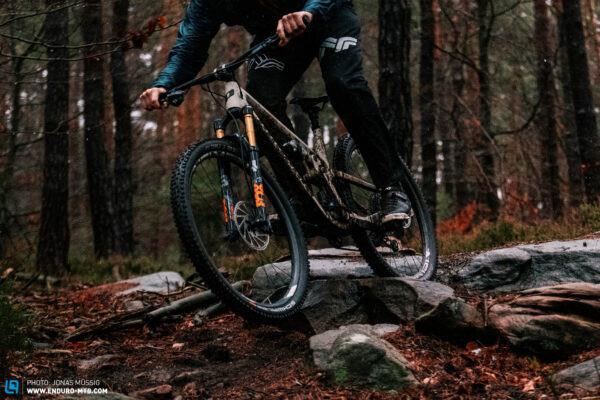 Various types of mountain bike fenders showcasing different designs and lengths
Various types of mountain bike fenders showcasing different designs and lengths
Exploring Different Types of Mountain Bike Fenders
Mountain bike fenders aren’t a one-size-fits-all accessory. They come in various designs, each with its own strengths and weaknesses. Understanding these differences is key to choosing the right type for your riding style and conditions. One of the primary differentiators is fender length.
Fender Length: Short vs. Long
Short Fenders: These minimalist fenders are popular for their unobtrusive design and ease of year-round use. They typically mount close to the tire and offer a degree of splash protection, mainly deflecting mud and water spray directed upwards towards your face.
- Pros: Lightweight, aesthetically subtle, can be left on the bike permanently, offer some protection in light mud or rain, less likely to interfere with bike racks or chairlifts.
- Cons: Limited protection compared to longer fenders, may not be sufficient in heavy mud or persistent rain.
Long Fenders: Designed for maximum protection, long fenders extend further forward and sometimes rearward, providing significantly more coverage. They are the go-to choice for riders who frequently encounter very muddy conditions and prioritize staying as clean and dry as possible.
- Pros: Superior mud and spray protection, keep both rider and bike cleaner, better protection for fork seals.
- Cons: More visually prominent, may not be desirable for year-round use, can sometimes interfere with bike racks or chairlifts, potentially heavier than short fenders.
Fender Attachment Methods
Beyond length, the way a bicycle fender attaches to your mountain bike is another important consideration, influencing ease of installation, compatibility, and security. Common attachment methods include bolt-on, cable ties, and Velcro straps.
Bolt-On Fenders: These fenders are designed to be directly bolted to specific fork models that feature mounting points on the fork arch.
- Pros: Clean and integrated look, very secure and rattle-free, often designed for optimal fit and performance with compatible forks, no risk of scratching fork paint from straps.
- Cons: Limited compatibility – typically only fit specific fork models (often from the same brand), require tools for installation (Allen key), can be fiddly to install due to small screws.
Cable Tie Fenders: These versatile fenders attach using zip ties or cable ties looped around the fork legs and stanchions.
- Pros: Wide compatibility – fit most suspension forks regardless of brand, relatively easy to install, secure when properly tightened, often more affordable than bolt-on models.
- Cons: Can scratch fork paint if not properly installed or if debris gets trapped underneath, cable ties are single-use and create waste if fenders are frequently removed, may require trimming cable ties for a clean look.
Velcro Strap Fenders: Similar to cable tie fenders in terms of general design, Velcro strap fenders utilize reusable Velcro straps for attachment.
- Pros: Tool-free installation and removal, very quick and easy to attach and detach, wide compatibility, reusable straps are more environmentally friendly than cable ties.
- Cons: Can be less secure than bolt-on or cable tie fenders if straps loosen, potential for rattling if not tightly secured, can also scratch fork paint, Velcro straps may wear out over time.
 Illustrations showing different mudguard attachment methods: bolt-on, cable ties, and Velcro straps
Illustrations showing different mudguard attachment methods: bolt-on, cable ties, and Velcro straps
Mountain Bike Fender Compatibility: What You Need to Know
Ensuring compatibility is a crucial step before purchasing bicycle fenders for your mountain bike. While most fenders are designed to be broadly compatible, certain factors can affect fitment.
Wheel and Tire Compatibility: The good news is that the vast majority of mountain bike fenders are designed to be compatible with all common wheel sizes: 26-inch, 27.5-inch (650b), and 29-inch wheels. Similarly, most fenders accommodate typical mountain bike tire widths, generally up to 2.6 inches and often even 3 inches or wider. However, it’s always wise to check the manufacturer’s specifications to confirm compatibility, especially if you run particularly wide tires.
Fork Compatibility: Fork compatibility is where you need to pay closer attention, particularly with bolt-on fenders.
-
Bolt-On Fender Compatibility: Bolt-on fenders are often brand-specific and designed to fit only certain fork models, typically from the same manufacturer. For example, a FOX bolt-on fender is generally designed for newer FOX forks with the necessary mounting points. Similarly, RockShox offers bolt-on fenders for their compatible forks. Always verify that a bolt-on fender is specifically listed as compatible with your exact fork model before purchasing.
-
Strap-On Fender Compatibility (Cable Tie and Velcro): Strap-on fenders are significantly more versatile in terms of fork compatibility. Due to their attachment method, they can generally be fitted to almost any suspension fork, regardless of brand or model. This includes forks from major manufacturers like FOX and RockShox, as well as smaller brands like BOS, DVO, EXT, Öhlins, and Formula. The primary exceptions are forks with unconventional designs, such as Manitou Mezzer forks with their rear-facing fork arch or upside-down forks like those from Intend or Bright, which may present mounting challenges for some strap-on fenders.
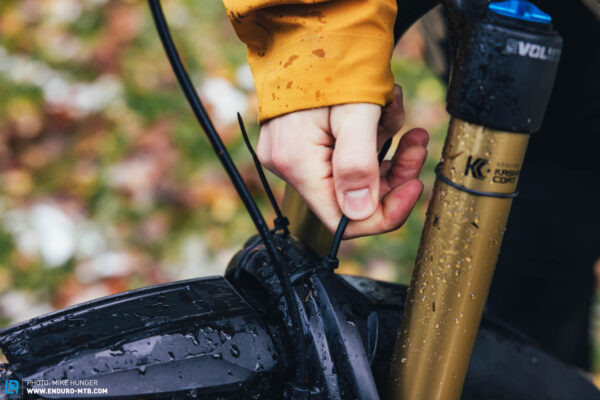 Image of a mountain bike fork with a fender attached, emphasizing compatibility
Image of a mountain bike fork with a fender attached, emphasizing compatibility
Our Testing Process: How We Evaluated Mountain Bike Fenders
To provide you with informed recommendations, we put a range of mountain bike fenders through rigorous real-world testing. Our evaluation process was designed to simulate diverse riding conditions and assess fender performance across key criteria.
Real-World Trail Testing: Over several months, we seized every opportunity to test the fenders on our local trails. This included weekend rides and dedicated test sessions. We intentionally rode in a wide spectrum of conditions, from dry and dusty trails to thoroughly soaked and muddy terrain. In fact, during some phases of testing, we actively sought out the muddiest trails available to push the fenders to their limits!
Back-to-Back Comparisons: To ensure a fair and direct comparison of protective effectiveness, we conducted back-to-back tests, riding with different fenders on the same day and on the same muddy trails. This allowed us to directly observe and compare how each fender performed in identical conditions, minimizing variables.
Evaluation Criteria: Our testing focused on several key performance aspects:
- Mud Protection: How effectively did the fender prevent mud and spray from reaching the rider’s face and eyes?
- Fork Seal Protection: How well did the fender shield fork seals from mud and debris buildup?
- Rattle and Noise: Did the fender produce distracting noises or vibrations while riding?
- Ease of Installation and Removal: How easy was it to mount and dismount the fender, particularly in trailside conditions?
- Durability and Material: Did the fender material withstand trail abuse and maintain its shape?
Through this comprehensive testing process, we gained valuable insights into the strengths and weaknesses of each fender model, allowing us to provide you with well-founded recommendations for choosing the best bicycle fenders for your mountain bike.
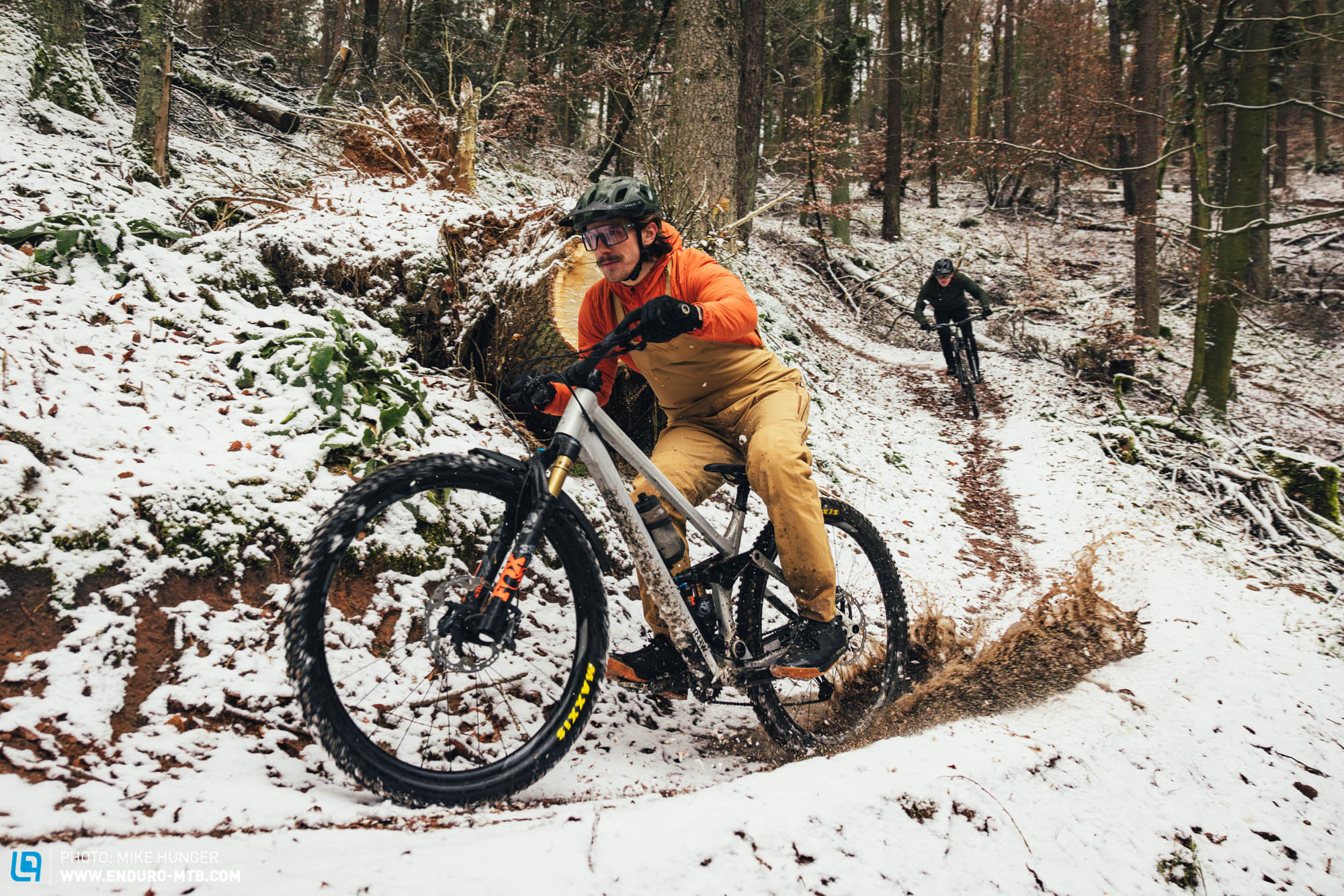 A muddy mountain bike tire and fender after a test ride, illustrating real-world testing
A muddy mountain bike tire and fender after a test ride, illustrating real-world testing
Top Picks and Considerations: A Glance at Mudguard Models
Based on our extensive testing, we’ve compiled a brief overview of various mountain bike fender models, highlighting their key characteristics and performance aspects. This is not an exhaustive review, but rather a snapshot to give you an idea of the options available and their general strengths and weaknesses.
Minimalist Options:
- RockShox Fender: The smallest fender in our test, offering minimalist protection. Best suited for riders prioritizing a subtle look and year-round use in হালকা mud conditions.
- Riesel Design Kol:oss: A classic, compact mudguard design from a German brand. Provides better protection than no fender at all, appealing to riders who prefer a less obtrusive option.
Mid-Range Protection:
- FOX Mudguard: Designed for integration with FOX forks, offering mid-level protection and a sleek appearance. Installation can be a bit more time-consuming compared to some strap-on models.
- Zéfal Deflector FM30: A good value option providing decent protection at a fair price. Utilizes cable ties for attachment, offering quick installation, though not ideal for frequent on-off use.
Maximum Protection Models:
- Mucky Nutz MugGuard Long: A long fender designed for maximum mud protection. Offers the best coverage in our test, attaching with Velcro straps. Some rattling may occur, and strap tightening can be slightly cumbersome.
- Mudhugger EVO Bolt-On: A bolt-on fender notable for its compatibility with various fork brands (using adapters). Provides excellent protection, second only to the Mucky Nutz in our test. Slight rattling and higher price point were noted.
Style and Customization:
- Slicy Enduro/DH Long Mudguard: Appeals to riders seeking personalization. Offers various pre-designed graphics and an online configurator for custom designs, allowing you to personalize your fender.
Top Performer:
- SKS MUDROCKER FRONT: Our top pick, consistently performing well across all criteria. Provides excellent protection for both rider and fork, with a user-friendly Velcro strap system for fast, tool-free installation. Protective tape is included to prevent fork scratches. A well-deserved “Best in Test” winner.
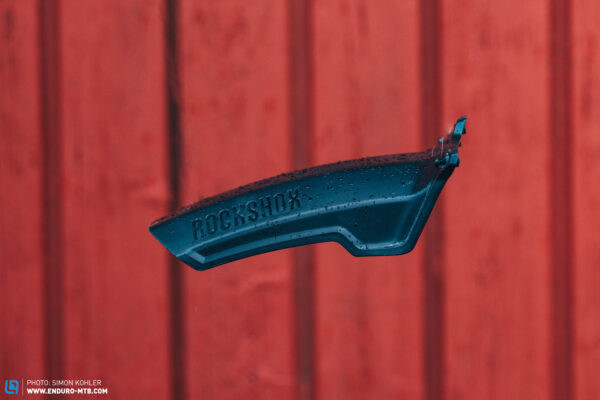 Collage of different mudguard models tested, showcasing variety in design and brand
Collage of different mudguard models tested, showcasing variety in design and brand
The Verdict: Choosing the Right Bicycle Fender for Your Mountain Bike
Bicycle fenders are an indispensable accessory for mountain bikers who don’t shy away from riding in wet and muddy conditions. They significantly enhance comfort, visibility, and bike component longevity. While all the fenders we tested offer a noticeable degree of protection, performance variations exist, particularly in terms of coverage, ease of use, and attachment methods.
When selecting bicycle fenders for your mountain bike, consider your typical riding conditions. If you frequently encounter heavy mud, longer fenders like the Mucky Nutz MugGuard Long or Mudhugger EVO Bolt-On will provide superior protection. For riders in milder conditions or those seeking a fender for occasional rain showers, shorter, more minimalist options like the RockShox Fender or Riesel Design Kol:oss might suffice and offer the benefit of year-round usability.
Attachment method is another key consideration. Bolt-on fenders offer a clean look and secure fit for compatible forks, while strap-on fenders (cable tie or Velcro) provide broader compatibility and easier installation, albeit with a potential trade-off in security or risk of fork scratching. Ease of installation is particularly important for larger fenders that you might want to attach and detach depending on weather.
Ultimately, the best bicycle fender for your mountain bike is the one that best balances your need for mud protection, ease of use, compatibility with your bike, and personal preferences. Investing in a quality mudguard is a worthwhile upgrade that will significantly improve your wet-weather mountain biking experience, keeping you cleaner, drier, and focused on enjoying the ride.


